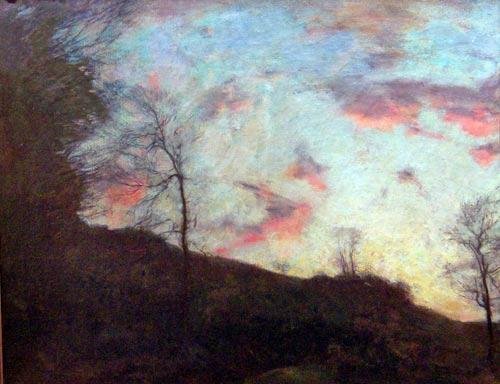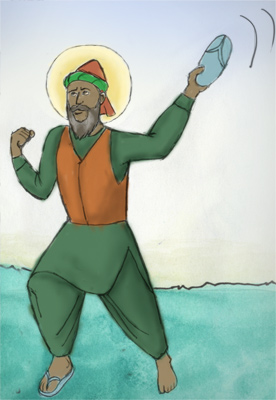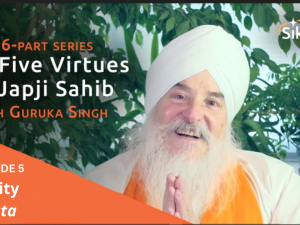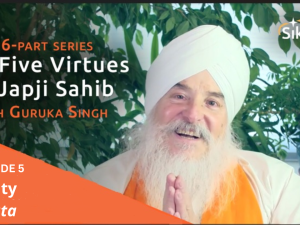
The United States and much of the western world is now preparing to celebrate Halloween. Mexico and many Latin Americans In the U.S and Canada celebrate the "Dia de los Muertos" or "Day of the Dead". Some of the mythology surrounding these festivities dates back to the ancient Aztecs and the ancient Celts in Europe. There are holidays in many other places in the world that have a similar mythology. Any thinking American might ask, "Where does this holiday actually come from? What does it mean?"
Christmas is supposed to have something to do with Jesus, the Easter Bunny has something to do with the spring season... eggs, right? So does Halloween mean anything? More importantly, what does Sikhi have to say on the subject? Halloween clearly has something to do with spirits, and the dead. The history and teachings of the Gurus offer a wealth of knowledge on those subjects. This is what we would like to explore.
 Hundreds of years ago, winter was
an uncertain and frightening time. Food supplies often ran low and,
for the many people afraid of the dark, the short days of winter coming on were
full of constant worry. "Halloween" means "hallowed evening" (i.e. sacred evening) and was generally called "All Hallows Eve." Why was it considered sacred?
Hundreds of years ago, winter was
an uncertain and frightening time. Food supplies often ran low and,
for the many people afraid of the dark, the short days of winter coming on were
full of constant worry. "Halloween" means "hallowed evening" (i.e. sacred evening) and was generally called "All Hallows Eve." Why was it considered sacred?
On Halloween,it was believed that souls who were trapped between the worlds (souls of people who were attached to earthly things and therefore unable to leave the earth's magnetic field) and so existed here as ghosts were uneasy and roamed freely. It was sthought that praying for these souls to be released would facilitate their departure. The day following All Hallows Eve" is called "All Saints Day" because the new light of morning brought the blessings of the saints upon these trapped souls thereby enabling them to depart from the earthly plane and be released from their torment.
On All Hallows Eve, people thought that they would encounter ghosts if they left their homes. To avoid being recognized by these ghosts, people would wear masks when they left their homes after dark so that the ghosts would mistake them for fellow spirits.In order to keep ghosts away from their houses, people would place bowls of food outside their homes to appease the ghosts and prevent them from attempting to enter. Hence the origin of 'treats' on Halloween." [History.com]
The tradition of dressing up for Halloween originated from common people who believed they could trick disembodied spirits. For Harijot Singh, this idea seemed absurd. "If there really was a time of year spirits had more access to the earthly realm, of coarse they could tell who is human and who else is a fellow disembodied spirit." This idea, however, reminded him of a more significant teaching. He explains, "I'm sure there are a lot of spirits of different kinds with different levels of consciousness but I'm sure they wouldn't be that easy to trick... but somehow this reminded me of a story I heard about Bhagat Kabir. The story was that there was a Jamdoot (messenger of death) who was getting egotistical. He was getting all puffed up because of how afraid people were of him. He's this scary angel of death. So Yam Raj sends him to Kabir. Bhagat Kabir beats him with his chapals and the Jamdoot leaves humbled. That's basically it, I love that story. I was reminded of this story and I thought, 'Well this Jamdoot did get tricked'. It's kind of a fun idea but of coarse when it comes to Bhagat Kabir, who has so many great writings in the SGGS, there is also great depth and mastery."
 Harijot Singh, who manages the children's
audio stories on SikhNet's homepage, then realized he had to put that
story up for this Halloween season. "I figured, there's tons of
people out there dressing up for Halloween but they don't even know
why. I mean think about it, that adds up to a lot of educated people,
all doing something for no real reason. For such a well educated country
we sure do a lot of mindless things. I'm grateful to have a different
cultural reference I get from being a Sikh. Anyways, I thought why shouldn't
we share this story which really does have significance? I'm not going
to any Halloween parties this year, instead I'm going to a huge Nagar
Kirtan in Yuba City, but I thought I'm in a perfect place to give people
something to think about. I thought it will be good for people whether
they celebrate Halloween or not."
Harijot Singh, who manages the children's
audio stories on SikhNet's homepage, then realized he had to put that
story up for this Halloween season. "I figured, there's tons of
people out there dressing up for Halloween but they don't even know
why. I mean think about it, that adds up to a lot of educated people,
all doing something for no real reason. For such a well educated country
we sure do a lot of mindless things. I'm grateful to have a different
cultural reference I get from being a Sikh. Anyways, I thought why shouldn't
we share this story which really does have significance? I'm not going
to any Halloween parties this year, instead I'm going to a huge Nagar
Kirtan in Yuba City, but I thought I'm in a perfect place to give people
something to think about. I thought it will be good for people whether
they celebrate Halloween or not."
So off he went to work composing a script for a new audio story. A story which hopes to remind people of something beyond this world. "We all have souls right?... Then we die and our souls go somewhere. Guru Nanak always writes about how many worlds upon worlds there is. When I looked in to it even just a little, I was reminded of how much the Sikh teachings deal with death. So I was trying to put that in there." Listen to "Death's Proud Messenger"
Bhagat Kabir's writings have a lot of references to death. Here is one example:
This Shabad is on Pannaa 327
Gauree, Kabeer Jee:
That death which terrifies the entire world.
The nature of that death has been revealed to me, through the Word of the Guru's Shabad. ||1||
Now, how shall I die? My mind has already accepted death.
Those who do not know the Lord, die over and over again, and then depart. ||1||Pause||
Everyone says, "I will die, I will die."
But he alone becomes immortal, who dies with intuitive understanding. ||2||
Says Kabeer, my mind is filled with bliss; my doubts have been eliminated, and I am in ecstasy. ||3||20||
This story is not like many stories from
the Gurus. It involved messengers of death and realms beyond the earth.
"On this one, I actually penciled the outline for the Messenger
[of Death]. Gurujot Singh decided to draw the outline for Kabir. Then he
did a really great job coloring it all in. In the end the picture is
small enough not to show the care he took with all the shading and effects
he does. I really liked how the picture turned out, I think it's awesome."




Harijot spends 24 hours a week composing scripts, finding story tellers, recruiting back up voices, searching for sound effects, selecting background music and editing all the audio together with whatever other work he might do at SikhNet. "It's actually a pretty involved process. I'll edit a piece for several hours, then I'll look back and be like 'Wow, that only adds up to four minutes of finished audio!' I mean it can take a lot longer than you might think with these multiple tracks. For some stories I have to put an event in the Guru's life in a way that will both make sense for kids and conveys the message without changing it. I'm always on SikhiToTheMax, checking lines from the Guru and working it in there."
The stories aren't just for children
though. Certainly any Sikh will find the messages in the stories endearing
and maybe also entertaining. Harijot explains, "I think of it like
the movie Finding Nemo. It's a kids movie but even a guy like me enjoyed
it. It had these amazing special effects, action, they slipped in some
humor that adults would enjoy but wasn't dark or inappropriate for kids.
That's how I think of these stories, the adults I share them with really enjoy them. It's the Guru's teachings, and sure we all have something
to learn from it! It's definitely not just for kids. I started to really
like the idea of audio. We're so used to movies, it's so easy, there's
no room for imagination. With audio stories you use your own imagination,
something we could all use more of, I don't care how old you are. People
should listen to them and find which ones they enjoy and spread them
around to everyone." SikhNet.com/Stories
-Guruka Singh






